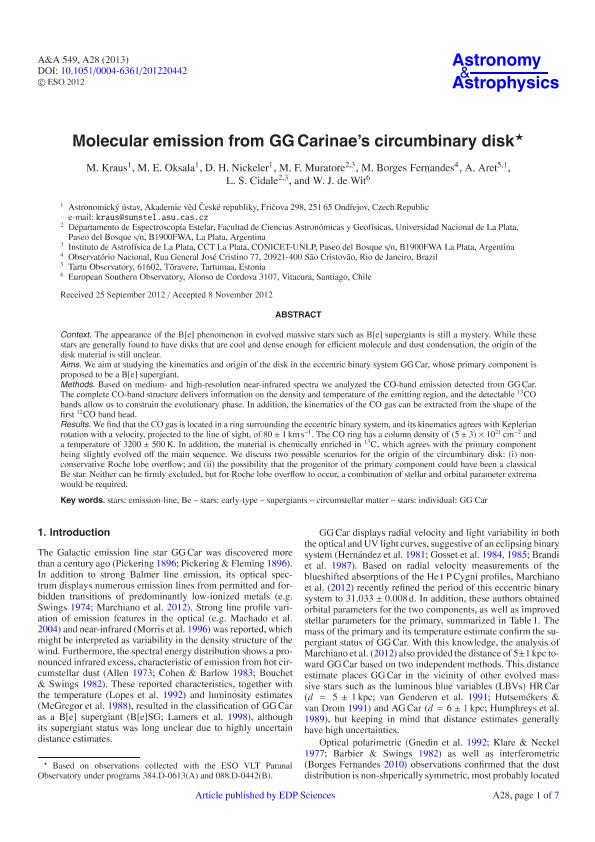Mostrar el registro sencillo del ítem
dc.contributor.author
Kraus, M.
dc.contributor.author
Oksala, M. E.
dc.contributor.author
Nickeler, D. H.
dc.contributor.author
Muratore, M. F.
dc.contributor.author
Borges Fernandes, M.
dc.contributor.author
Aret, A.
dc.contributor.author
Cidale, Lydia Sonia

dc.contributor.author
de Wit, W. J.
dc.date.available
2016-11-23T15:06:51Z
dc.date.issued
2013-01
dc.identifier.citation
Kraus, M.; Oksala, M. E.; Nickeler, D. H.; Muratore, M. F.; Borges Fernandes, M.; et al.; Molecular emission from GG Carinae's circumbinary disk; Edp Sciences; Astronomy And Astrophysics; 549; A28; 1-2013; 1-8
dc.identifier.issn
0004-6361
dc.identifier.uri
http://hdl.handle.net/11336/8290
dc.description.abstract
The appearance of the B[e] phenomenon in evolved massive stars such as B[e] supergiants is still a mystery. While these stars are generally found to have disks that are cool and dense enough for efficient molecule and dust condensation, the origin of the disk material is still unclear. We aim at studying the kinematics and origin of the disk in the eccentric binary system GG Car, whose primary component is proposed to be a B[e] supergiant. Based on medium- and high-resolution near-infrared spectra we analyzed the CO-band emission detected from GG Car. The complete CO-band structure delivers information on the density and temperature of the emitting region, and the detectable 13CO bands allow us to constrain the evolutionary phase. In addition, the kinematics of the CO gas can be extracted from the shape of the first 12CO band head. We find that the CO gas is located in a ring surrounding the eccentric binary system, and its kinematics agrees with Keplerian rotation with a velocity, projected to the line of sight, of (80pm 1) km/s. The CO ring has a column density of (5pm 3)x10^21 cm^-2 and a temperature of 3200pm 500 K. In addition, the material is chemically enriched in 13CO, which agrees with the primary component being slightly evolved off the main sequence. We discuss two possible scenarios for the origin of the circumbinary disk: (i) non-conservative Roche lobe overflow, and (ii) the possibility that the progenitor of the primary component could have been a classical Be star. Neither can be firmly excluded, but for Roche lobe overflow to occur, a combination of stellar and orbital parameter extremawould be required.
dc.format
application/pdf
dc.language.iso
eng
dc.publisher
Edp Sciences

dc.rights
info:eu-repo/semantics/openAccess
dc.rights
Atribución-NoComercial-CompartirIgual 2.5 Argentina (CC BY-NC-SA 2.5 AR)
dc.rights.uri
https://creativecommons.org/licenses/by-nc-sa/2.5/ar/
dc.subject
Emission Lines
dc.subject
Early Type Stars
dc.subject
Supergiants
dc.subject
Circumstellar Matter
dc.subject
Gg Car (Estrella)
dc.subject
B Stars
dc.subject.classification
Astronomía

dc.subject.classification
Ciencias Físicas

dc.subject.classification
CIENCIAS NATURALES Y EXACTAS

dc.title
Molecular emission from GG Carinae's circumbinary disk
dc.type
info:eu-repo/semantics/article
dc.type
info:ar-repo/semantics/artículo
dc.type
info:eu-repo/semantics/publishedVersion
dc.date.updated
2016-11-18T15:11:30Z
dc.journal.volume
549
dc.journal.number
A28
dc.journal.pagination
1-8
dc.journal.pais
Francia

dc.journal.ciudad
Paris
dc.description.fil
Fil: Kraus, M.. Astronomický ústav; República Checa
dc.description.fil
Fil: Oksala, M. E.. Astronomický ústav; República Checa
dc.description.fil
Fil: Nickeler, D. H.. Astronomický ústav; República Checa
dc.description.fil
Fil: Muratore, M. F.. Universidad Nacional de la Plata. Facultad de Ciencias Astronómicas y Geofísicas; Argentina
dc.description.fil
Fil: Borges Fernandes, M.. Ministério de Ciencia, Tecnologia e Innovacao. Observatorio Nacional; Brasil
dc.description.fil
Fil: Aret, A.. Tartu Observatory; Estonia
dc.description.fil
Fil: Cidale, Lydia Sonia. Universidad Nacional de la Plata. Facultad de Ciencias Astronómicas y Geofísicas; Argentina
dc.description.fil
Fil: de Wit, W. J.. European Southern Observatory; Chile
dc.journal.title
Astronomy And Astrophysics

dc.relation.alternativeid
info:eu-repo/semantics/altIdentifier/url/http://adsabs.harvard.edu/abs/2013A%26A...549A..28K
dc.relation.alternativeid
info:eu-repo/semantics/altIdentifier/url/http://www.aanda.org/articles/aa/abs/2013/01/aa20442-12/aa20442-12.html
dc.relation.alternativeid
info:eu-repo/semantics/altIdentifier/doi/http://dx.doi.org/10.1051/0004-6361/201220442
Archivos asociados
